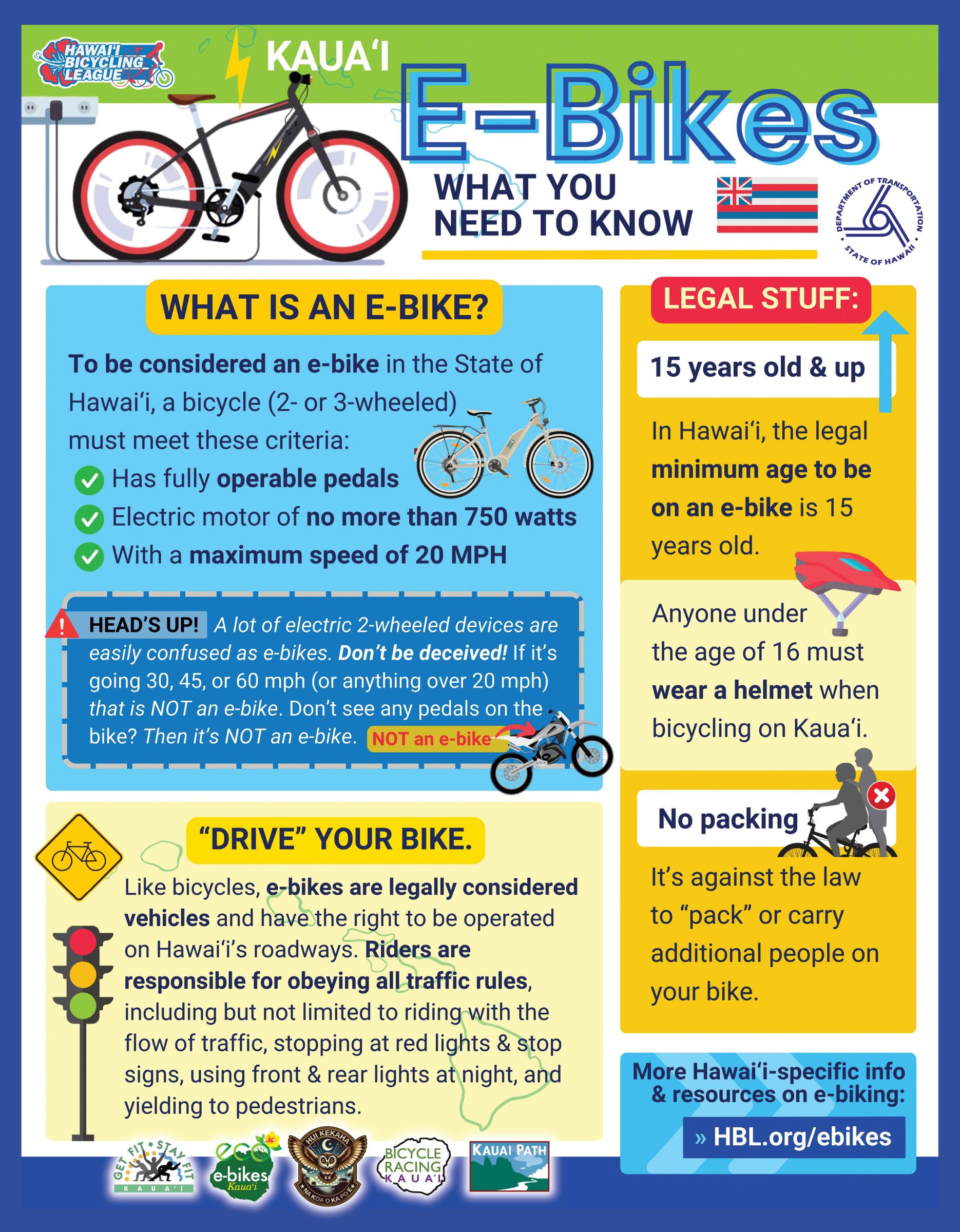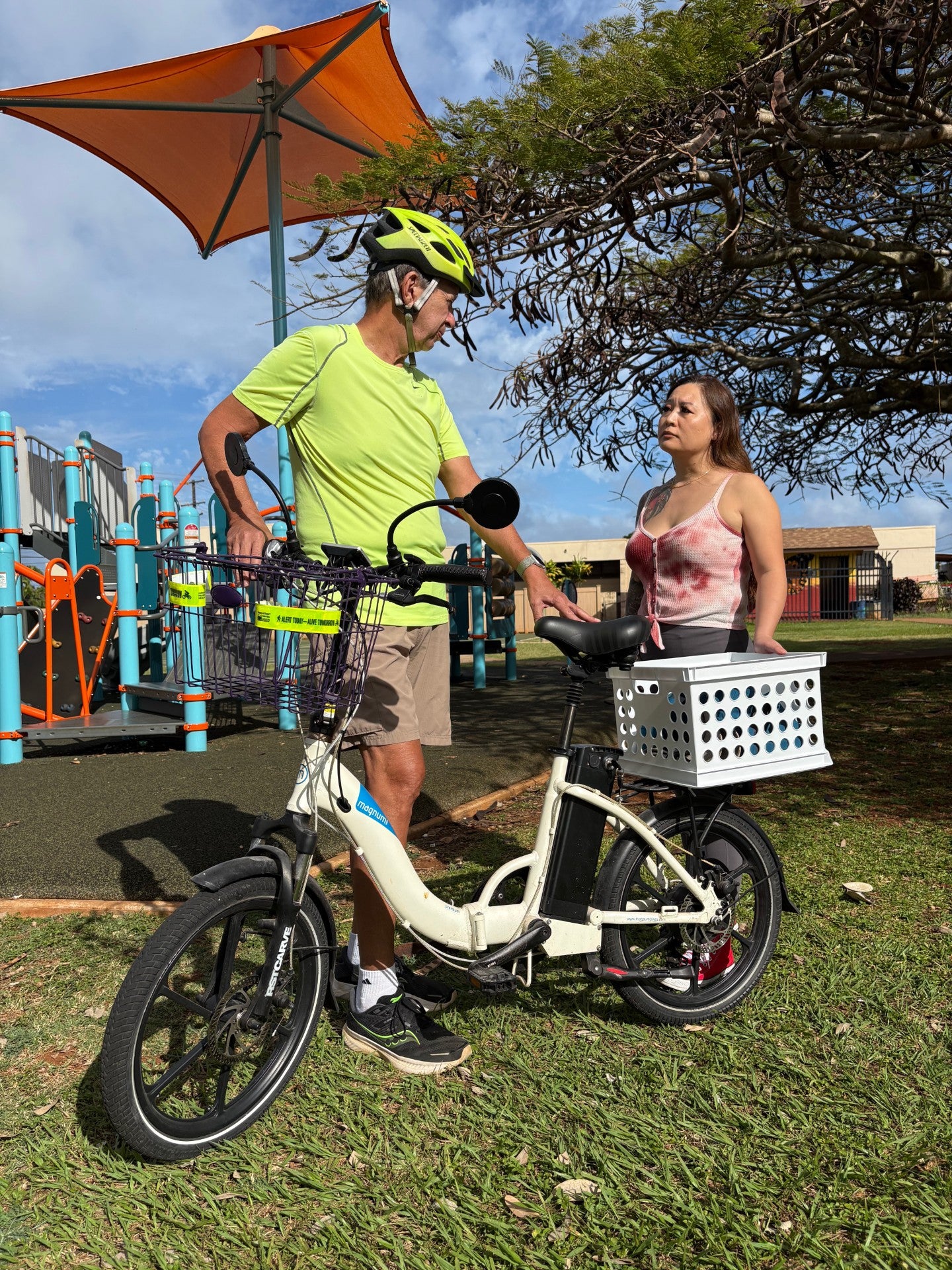E-Bikes What You Need to Know
E-Bikes, Keeping It Real
By Shannon Appelcline, Contributing Writer for Kauaʻi Path
On Feb. 1, two children riding a single e-bike on Kekaha Road were injured in a collision with a pickup truck. Unfortunately, this is a growing trend. E-bikes were the most common cause of injury for children treated by trauma services at the Kapiʻolani Medical Center in Q2 2024. Though they’re a great new way to get around, e-bikes must be ridden with safety in mind.
Kauaʻi Path, a nonprofit focused on making walking and bicycling commonplace in our neighborhoods through the stewardship of multiuse paths, is leading the charge for safety.
“Kauaʻi Path is committed to increasing public awareness of the benefits of e-bikes, as well as safety concerns they present,” Kauaʻi Path’s board president Dr. Randy Blake says. “We’ll be participating in community events over the coming months to present that information.”
Keeping It Classy
E-bikes are electric bikes. Their battery-powered motors help a bicycle move. However, different types of e-bikes have different advantages and different dangers—as well as different legal requirements. Knowing the major features of e-bikes is the first step in riding them safely. HB-958, which was introduced into the Hawaiʻi Legislature in January, defines three classes of e-bikes, broadly following national standards:
- Class 1: pedal-assist with motor limited to 20 mph.
- Class 2: pedal-assist bike with throttle and motor limited to 20 mph.
- Class 3: pedal-assist bike with throttle and motor limited to 28 mph. This class is not currently defined as an e-bike in Hawaiʻi.
Pedal-assist means the motor only kicks in when the rider is pedaling. An e-bike is not a moped or motorcycle, it just assists the rider. A throttle gives the bike a big, extra boost.
No e-bikes can be used on sidewalks in Hawaiʻi, although HB-958 will change this to allow riding at no more than 10 mph with class 1 or class 2 e-bikes, except in business districts. Otherwise, individual counties decide which classes of bikes to allow. The Ke Ala Hele Makālae path restricts e-bike use to Class 1. Class 3 e-bikes are forbidden from most bike paths.
Keeping It Safe
E-bikes are more powerful than traditional bikes, as 20 mph is faster than most cyclists ride. That means that existing dangers of biking are multiplied.
Unfortunately, the dangers of e-biking are multiplied again for children, due to their limited experience and increased risk-taking that often puts safety second. For example, two recent accidents involved “packing” two children on a bike.
The age restrictions on e-bikes need to be taken seriously. HB-958 offers some changes. There are no restrictions on class 1 e-bikes; riders must be at least 14 for class 2 e-bikes, unless they are under direct supervision; and riders must be at least 16 or for class 3 e-bikes.
The best way to be safe on an e-bike is the same as on a traditional bicycle. Wear a helmet. Don’t pack extra people on a bike built for one. Don’t bike faster than the environment allows, especially on multiuse paths. Use lights and wear bright clothing, even in daytime.
Keeping It Cool
E-bikes can be useful, particularly for older or disabled adults. Riders can go farther, more frequently. They can ride up Kauaʻi hills and into the face of the trade winds.
These bikes also enable the dream of a greener Garden Island. Jim Benkert saw this when he founded Eco E-Bikes Kauaʻi, which sells and rents e-bikes. He says that by building the interest in e-bikes now, we enable future infrastructure.
But like everything, e-bikes have their dangers. Children are at real risk on these powerful vehicles, which always need to be ridden with care and attention.


